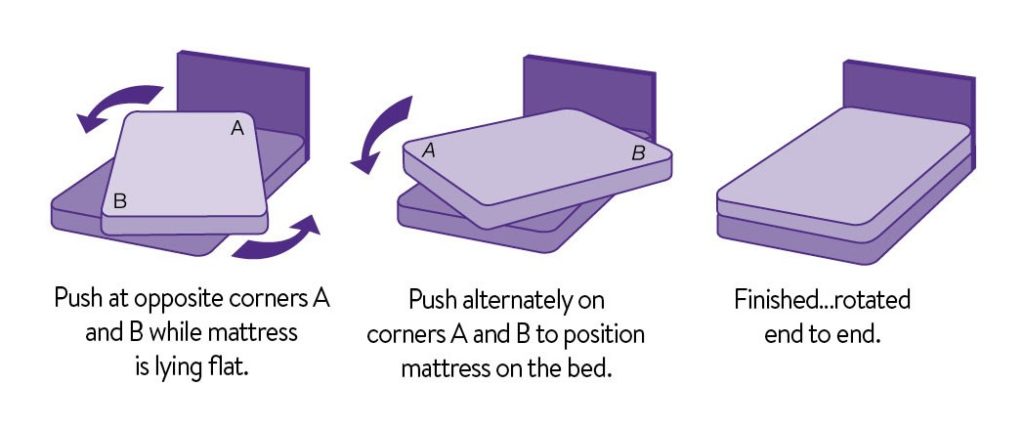What to expect when your new bed arrives

What to expect from your new bed
When your new bed arrives, it may feel firmer than your old one or the model you tried in the store. This is because as it hasn’t yet had time to contour to your body, which is completely normal! Over the first several weeks, the comfort layers will soften and mould to your unique shape for a perfect, custom fit. To ensure your mattress contours evenly, rotate it end-to-end every two weeks for the first four months and then every three months thereafter. It’s a good idea to also use a mattress protector, clean stains quickly, and regularly air and vacuum your mattress to keep it in tip-top shape!
Body impressions and mattress contouring
When you first wear a new pair of shoes, they may feel a little stiff or uncomfortable. However, as you continue to wear them, the shoes adjust to contours of your feet and eventually fit snugly.
The same thing happens with a new mattress. It might initially feel firmer and less comfortable than your old bed, but it will mould to your shape as you sleep on it, cradling and contouring to your body for maximum comfort.
All beds develop body impressions over time. Your mattress may take several weeks to contour to your unique shape as the comfort layers on top of your mattress adapt to pressure and movement. Normal levels for this contour adjustment are between 25mm – 35mm but this will depend on the mattress materials, as well as your body shape and size.
And don’t be alarmed if you lie on your new mattress for the first time and it feels different to the one you tried in store. Store beds have had a lot of people lie on them – your new bed has had no body to adjust to!
Prolonging the life of your mattress
Now your new bed has arrived, you’ll want to take the best possible care of it. Be sure to spot-clean any stains and vacuum it regularly to remove any dust or mites. Using a mattress protector is a great way to keep your mattress looking pristine and can help keep any nasties out!
The better care you take of the mattress’s spring support system and foam comfort layers, the longer the mattress will last. Regularly rotate your mattress end-to-end: more often in the first few months, then a few times a year after that. This helps your mattress settle and evens out the wear and tear so you don’t have to replace your bed too often!
Mattress turning instructions
To help even out body impressions, regularly rotate your mattress: every two weeks for the first four months, then once every three months after that. If you have two people sleeping on either side of a larger bed you may find that there are body impressions on either side of the less-used middle of the bed. This is also normal! Make an effort to lie on the entire mattress so the comfort layers settle evenly.


The Do’s When You Get Your New Mattress
DO turn and/or rotate your mattress frequently to ensure the components wear evenly.
DO carry your mattress flat or on its side. This is a job for two people: be kind to your back!
DO use a mattress protector. A quality mattress protector will help keep your mattress clean and extend its life. A waterproof mattress protector may be useful for children’s beds.
DO air your bed. Airing your bed periodically by leaving bedding off for several hours will allow any trapped moisture to evaporate.
DO vacuum your bed regularly using low suction, concentrating on any seams and stitching to remove debris, dust or mites.
DO treat spills and stains as soon as possible. Gently scrape away soiling or mop up any liquid. Use a damp (not wet) cloth to clean the surface and dry in shade away from direct heat. Allow to dry thoroughly before you use it again.
DO firmly push in all base legs/castors supplied with your new base. A stable surface will ensure your mattress stays flat and well-supported, avoiding strain on the springs and comfort layers.
DO replace your base when purchasing a new mattress. The base supports the entire mattress and old springs lose their strength and support. By using the intended base with your new mattress, you can mitigate any potential damage.
DO dispose of all plastic packaging immediately and appropriately. Bags can be recycled via the soft plastics recycling scheme, but can be dangerous for pets and young children. Please ensure you discard all plastic properly.
DO ensure you protect your mattress and base when transporting or storing your bed to prevent structural damage or condensation, which can cause dampness and mildew. This damage is not covered under the warranty.
The Don’ts When You Get Your New Mattress
DON’T leave plastic packaging lying around, as it is a suffocation hazard
Get a Better Nights Sleep with the right Sleepyhead Mattress:
Whether you sleep alone or share your bed, investing in the right size mattress is important to ensure a quality sleep. Don’t rush to buy a particular size mattress because that’s what you’ve always had. As a general rule of thumb, aim for the biggest mattress you can comfortably fit into the space you have available. You want to be able to spread out in bed, and still be able to open your cupboards, drawers, and move around your bedroom.
View our range of mattresses here or take our Sleep Selector Quiz to find the right mattress for you. Get more sleep tips and helpful information on our Sleep Guide, and explore the articles below before you buy your bed:
What’s the best mattress size for me?
